
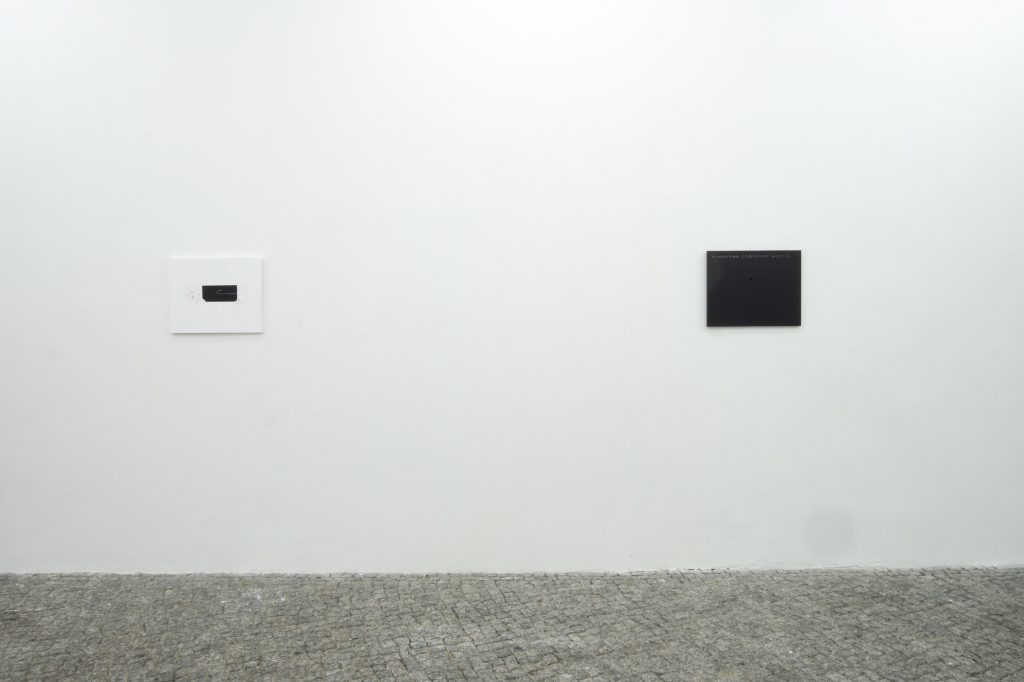
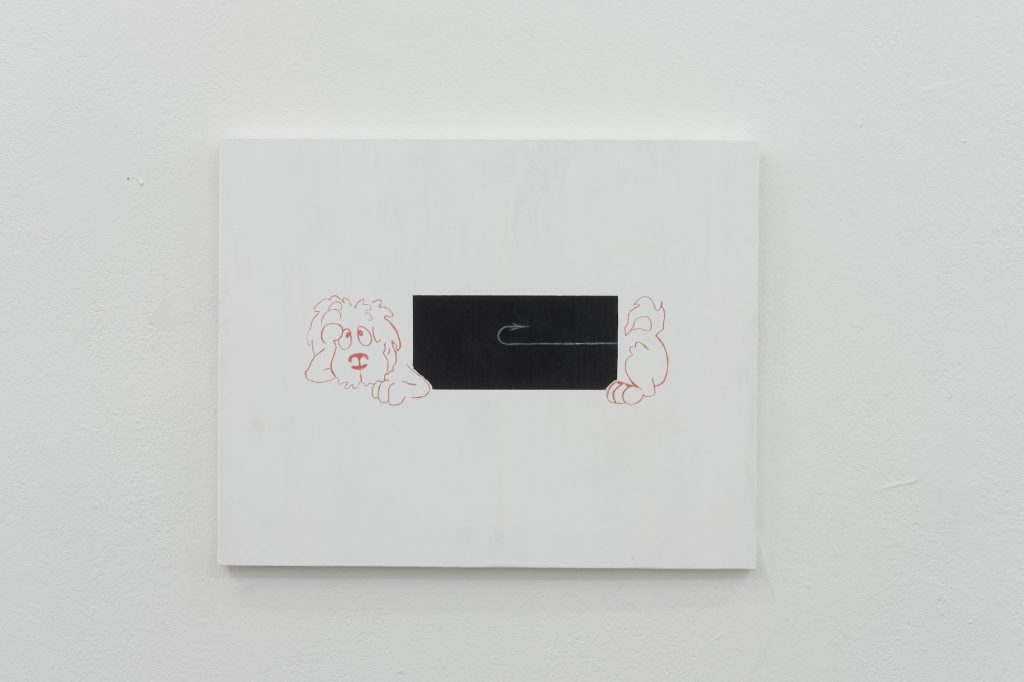
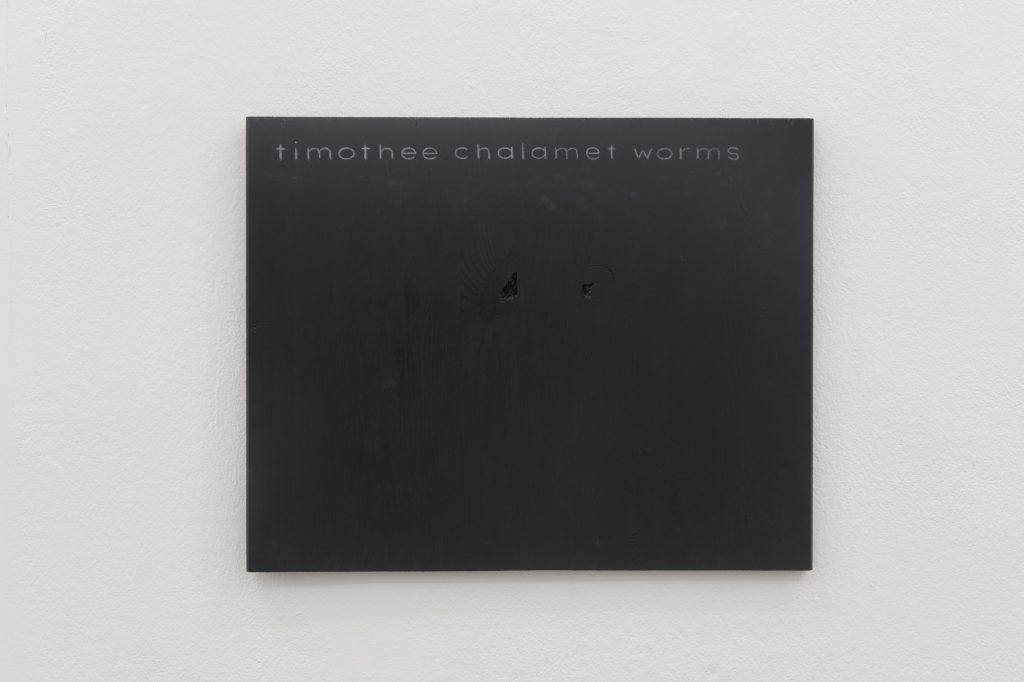
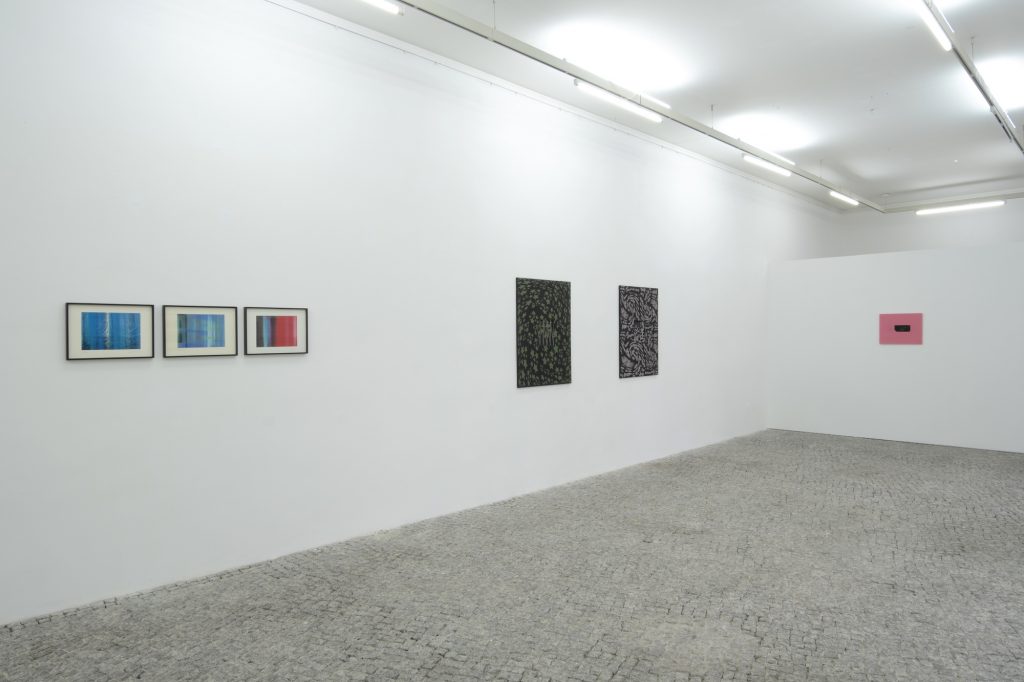
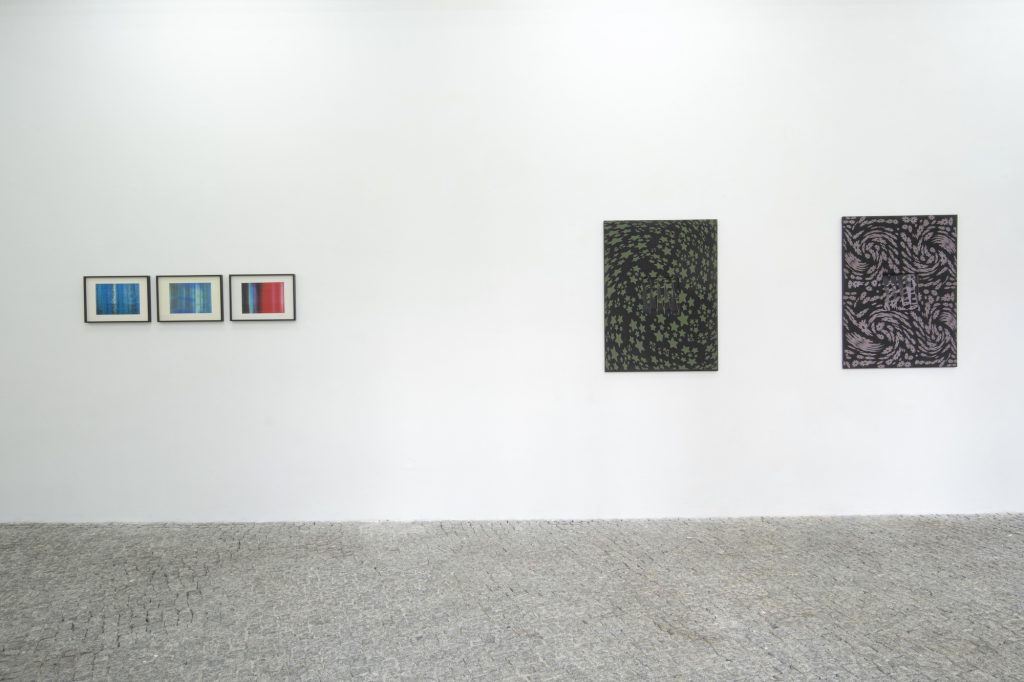
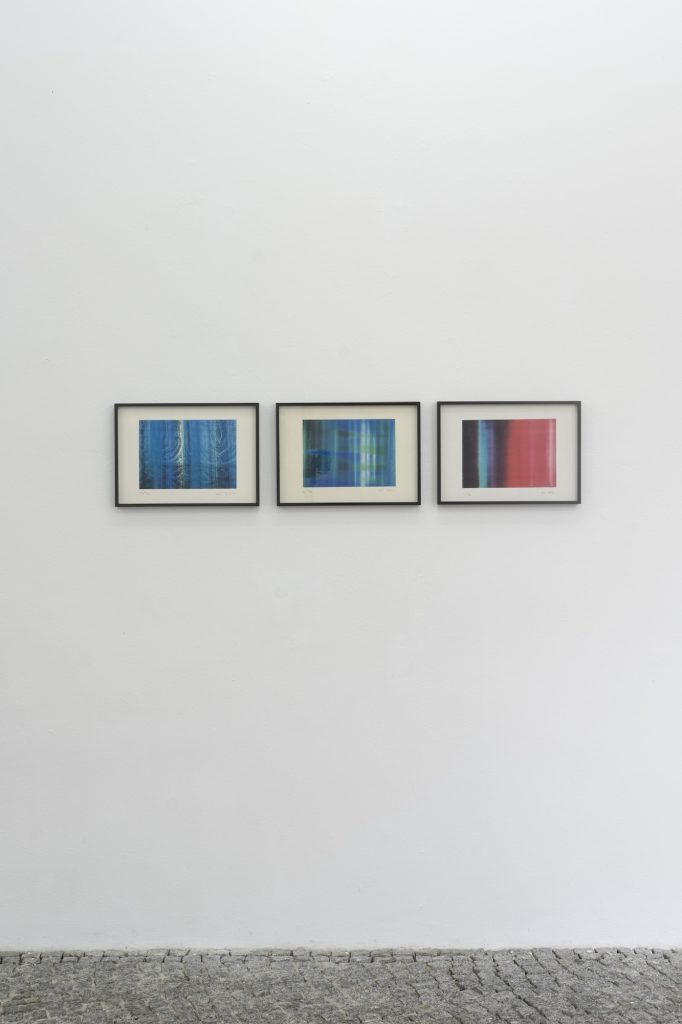

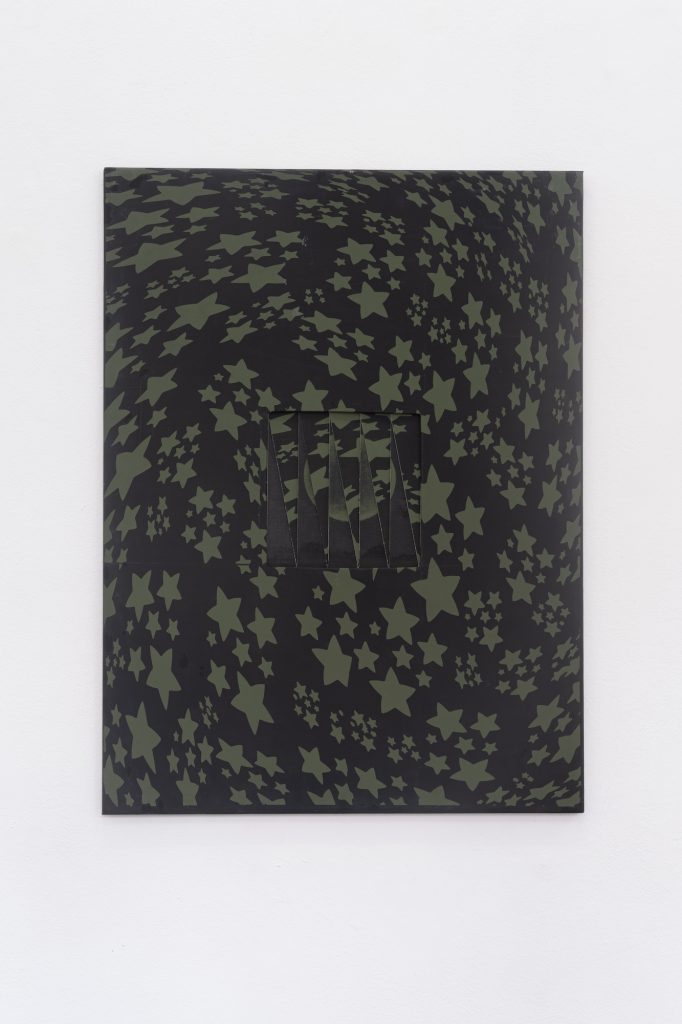
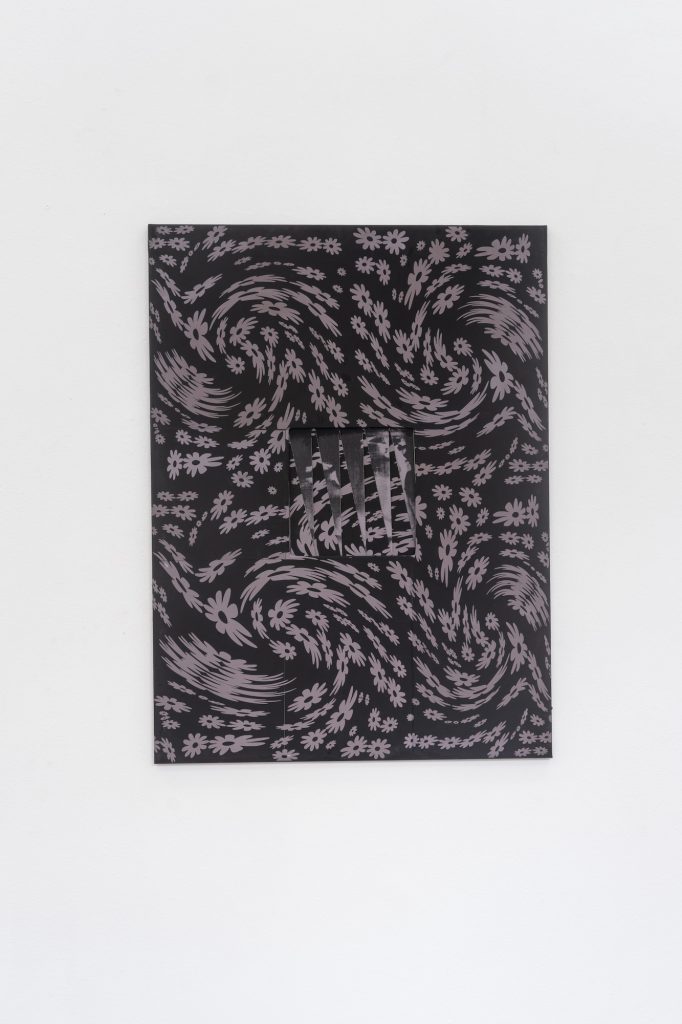
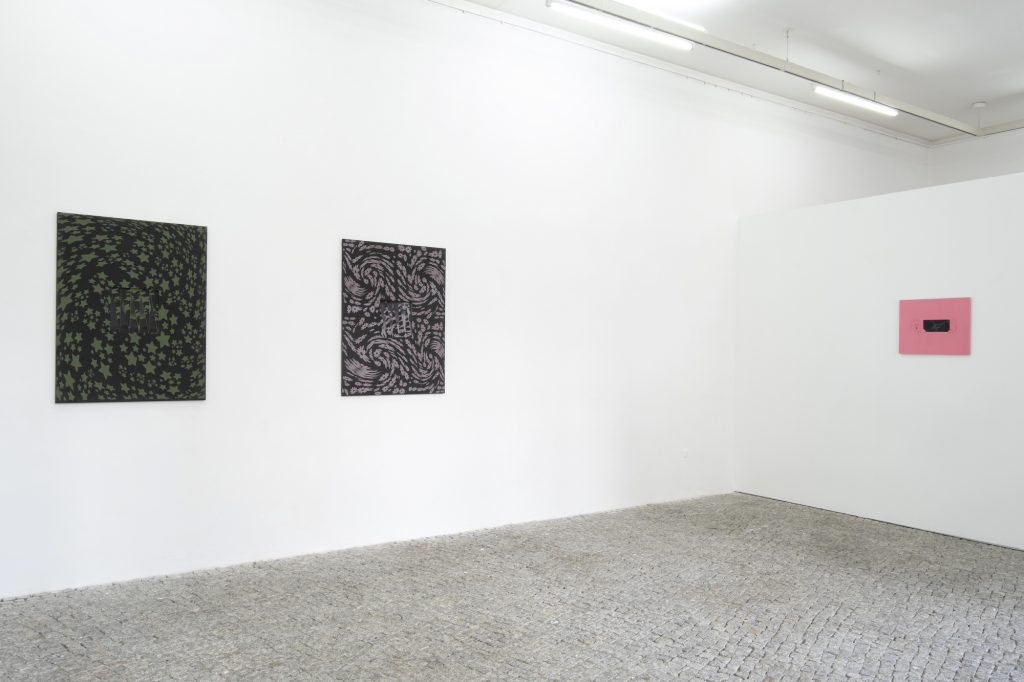


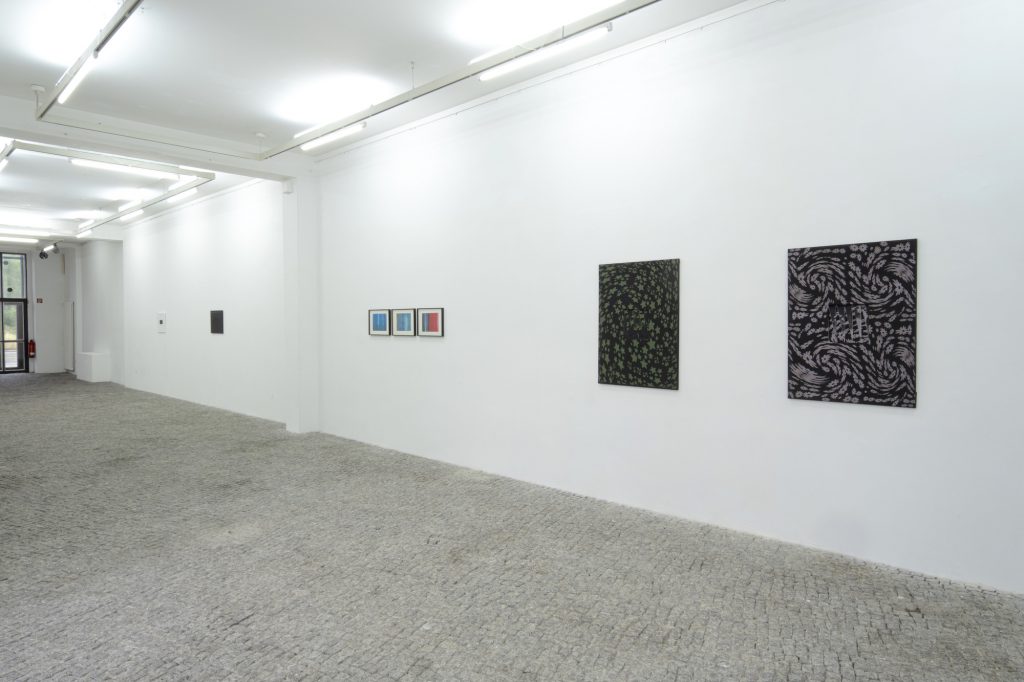
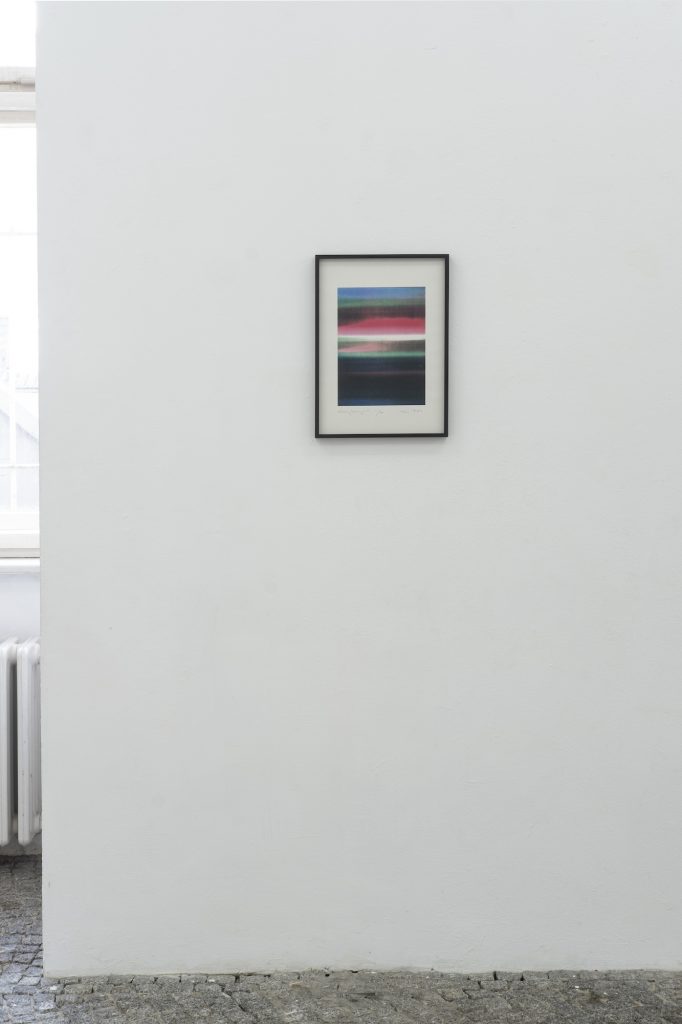
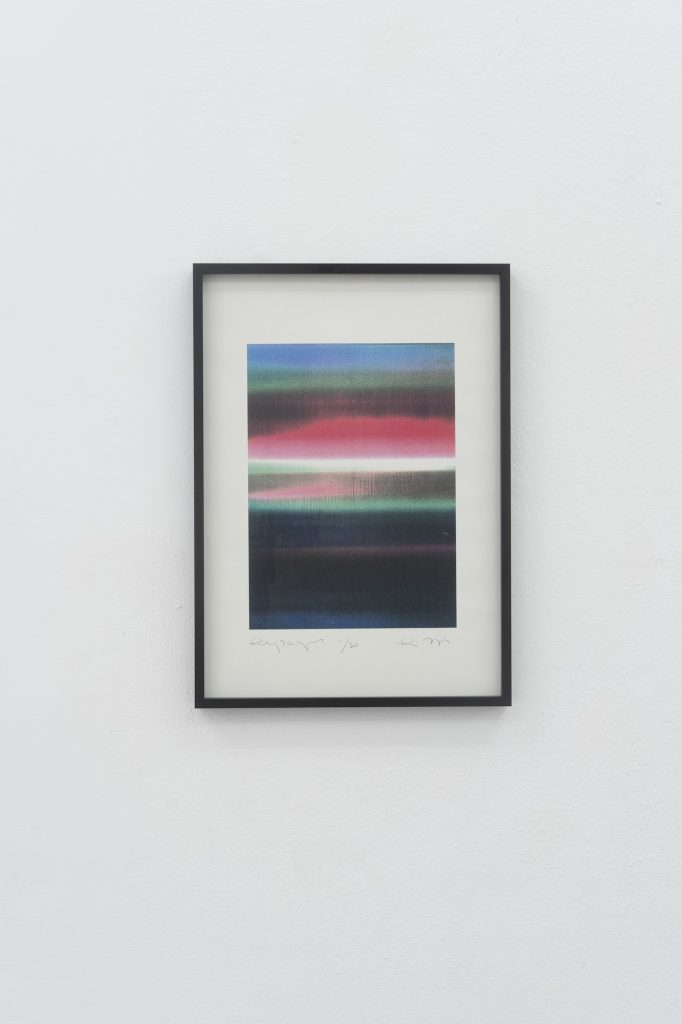
other people’s clothing, the exhibition featuring Kevin desbouis, Pati Hill and charlotte Houette, has already happened elsewhere1. some thoughts slumber while others stretch out. A mere effect of the sliding of the signifier2,or, in this case, of perception.
Yet, how can we grasp the attitudes towards disappearance which are inherent in forms, or more precisely, those processes of visibility that leave a fuzziness in which possible fictions and other attempts to slip away can emerge? Paintings and xerographs share gestures of appropriation, displacement or dissimulation, and evoke – through their repetition in space – changes of state, psychic or almost able to twist you (literally). some are more dramatic than others. some more comic than others. series, sequence, reproduction of motifs and printing techniques hint at attitudes that are closely related to editing3. Through these flattening actions, the notion of version extends to the surface of the forms, staging ‘tactics’ of subterfuge or trickery as regimes of visibility, present or deliberately absent. an anti-spectacular special effect that generates a distortion of the point of view.
iI, in its increasingly elaborate cinematographic handling, the special effect fades into the image, making it perceptible would be like creating an image that is no less special. one of those that draws you in and enchants you, triggering mechanisms of fiction and desire. Logics of appearance – or again, of concealment – that take you from one version of yourself to another. in a way, by being perceptible, the special effect assumes a role specific to illusion while at the same time revealing it, «toggling between wonder and trick»4. yet its attractiveness, however accessible, seems deceptive or suspicious, leading to an eventual distancing from it. a sort of gimmick, similar to what theorist sianne ngai describes in her book Theory of the Gimmick5, defining an aesthetic judgement and a capitalist form6 whose fascination and mistrust maintain this same slipping of judgement7. so much so, she says, that to recognise the gimmick is to recognise its power of illusion (to which we can be sensitive) while at the same time making the illusion transparent and putting it at a distance. so if the special effect is visible – like the punch line of a joke that we might have anticipated – is it still a special effect despite its ‘failed’ or tangible aspect?
In Kevin desbouis’s installations, intensity and indetermination operate in the recirculation of images, words and objects. He conceives his artworks as situations that are not explicit, or with a partially accomplished potential, which may encompass cinematic, erotic or repressed aspects. the distance between the object and the subject creates the potential for confusion, between deception and seduction. in the form of a hidden sequence or script, the wooden panels suggest instructions similar to an ambiguous motivations speech. there are also dogs performing an equivocal advertisement. in this scenario, comedy seems to melt with exasperation, and objects of constraint appear to us as x-ray visions or promises.
In the early 1970s, after a thirteen-year break from publishing, Pati Hill began photocopying her domestic environment. objects and garments are life-size recorded by the copier, conferring on them a distance free of nostalgic concerns. Pati Hill’s xerography abandons a sense of fascination in favour of abundance, revealing her keen attention to the limited objects around her. the bureaucratic machine associated with secretarial work plays a literal, compulsive role in Pati Hill’s work. Her xerographs from the 1990s contain many tiny variations. their abstraction is the result of multiple successive passages of each colour through the machine, making them part of a laborious process. The image returns them their fiction, their magic, and the machine returns their uncertainty. in their intimate format, they almost seem to ironise american abstract painting.
Charlotte Houette’s paintings create fantasmatic spaces in which wandering has distorting and shimmering effects. there are two kinds of aberrations, both chromatic and on the motif, that produce effects of bewilderment, the kind of psychological vehicles that are not intended to induce a semantic of emotions. Her works generate spatial loops that manipulate visibility systems, where motifs repeat and stretch, colouring a psychedelic and hallucinatory movement, but where the painting is anything but virtual. the structure of the paintings incorporates prototypical constructions, akin to scale models and the pop-up mechanisms of appearance and camouflage. Charlotte Houette’s work has a swirling, saturated atmosphere, as if never quite awake, with a lurking sensation of derealisation that affects us as much as the space in which they are displayed.
other people’s clothing deals with the notion of attitude, in which the possible ways of being and repositioning oneself in the world of reality indicate that something is always – and already – happening elsewhere (in an artistic practice, for example). the special effect produces forms in which paint and print merge in their relationship to the surface and an apparent superficiality. Yet it is several layers in a laborious process that give shape to unexpected plays of depth. retinal impressions fade, and associations of the mind, some of them more erotic or enigmatic, rush in and become necessary to make you fall head over heels. and, if you let yourself fall, these absorption phenomena can create confused, amazed presences.
Fiona Vilmer, June 2023
Special thanks to sophie vinet, Kevin desbouis, charlotte Houette, and to baptiste Pinteaux, nicole Huard, and florence bonnefous (Galerie air de Paris) for the presence of Pati Hill in this exhibition.
The exhibition is supported by les bains-douches (alençon, france), l’institut français, région normandie and Project space festival.
1.« The exhibition «other people’s clothing» took place at the art centre Les Bains-Douches in alençon, france, from 11 march to 24 april 2022. curated by fiona vilmer with Kevin desbouis, Pati Hill and charlotte Houette. at Gr_und (berlin), you are in the second occurrence of the exhibition.
2. a fragment from on of Jack Goldstein’s aphorisms.
3. a reference to the publishing practices of each of the artists in this exhibition. Kevin desbouis publishes the magazine Suckcess, an artist’s book that brings together several contributors and deals with issues of compromise, hatred, secrecy, self-erasure and the staging of the self. Pati Hill has published several novels (including One Thing I Know, 1962 ; reprinted in 2022 by daisy editions), collections of poems (including Slave Days, 1975) and made her own books in which her xerograph works are bound; charlotte Houette founded EEAPES with clara Pacotte, a research project on feminist science-fiction writing; they publish a series of readers containing previously unpublished writings and translations. she has also published and translated Faux Pas, a collection of writings by painter amy sillman, with after 8 books.
4. «Toggling between wonder and trick, overvaluation and correction, the gimmick thus draws into sharper relief something about the workings of comedy, just as comedy reveals the gimmick as aesthetic form.» in « Theory of the Gimmick » in Critical Inquiry, Comedy, an Issue, edited by lauren berlant and sianne ngai, volume 43, number 2, winter 2017. https://doi.org/10.1086/689672 5. sianne ngai, Theory of the Gimmick. Aesthetic Judgement and Capitalist Form, Harvard university Press, 2020.
6. in her book sianne ngai theorizes the gimmick as an aesthetic judgment and a virtual form in capitalism. the gimmick is “irritating yet strangely attractive”, it is “linked to our perception of an object making untrustworthy claims about the saving of time, the réduction of labour and the expansion of value.”
7. « It is more precisely the transformation of idea into thing in a way that charms but also disturbs us » in « Theory of the Gimmick » in Critical Inquiry, comedy, an issue, edited by lauren berlant and sianne ngai, volume 43, number 2, winter 2017. https://doi.org/10.1086/689672
*
other people’s clothing, l’exposition réunissant Kevin Desbouis, Pati Hill et Charlotte Houette a déjà eu lieu ailleurs(1). Recommencer l’exposition serait comme une manière d’apparaître, pas tout à fait de la même manière. Certaines pensées somnolent pendant que d’autres s’étirent. A mere effect of the sliding of the signifier (2) (Un simple effet de glissement du signifiant), ou ici de la perception.
Comment se saisir des attitudes de disparitions présentes dans les formes, ou plus exactement de ces processus de visibilité qui laissent surgir un flou d’où peuvent s’échapper de possibles fictions et autres tentatives pour s’éclipser ? Peintures, sérigraphies et xérographies partagent des gestes d’appropriation, de déplacement ou de dissimulation, et évoquent – par leurs répétitions dans l’espace – des changements d’états, psychiques ou presque susceptibles de vous tordre (littéralement). Certains sont plus ou moins dramatiques. Certains plus ou moins comiques. Séries, séquence, reproduction de motifs et techniques d’impressions laissent se deviner des attitudes liées à l’édition (3). Dans ces gestes d’aplatissements, la notion de version se répand à la surface des formes, mettant en scène des « tactiques » de subterfuge ou de trucage comme autant de régimes de visibilités présents ou délibérément absents. Un effet spécial anti-spectaculaire d’où peut émerger une distorsion du point de vue.
Si, dans son traitement cinématographique toujours plus élaboré, l’effet spécial s’estompe dans l’image, le rendre perceptible reviendrait à créer une image qui n’en est pas moins spéciale. De celles qui vous attrapent et vous enchantent, et déclenchent des mécanismes de fiction et de désir, des logiques d’apparition – ou là encore, de dissimulation -, vous faisant passer d’une version de vous-même à une autre. D’une certaine manière, en étant sensible, l’effet spécial endosse un rôle propre à l’illusion en même temps qu’il la divulgue, « oscillant entre l’émerveillement et l’astuce »(4). Cependant, son attractivité aussi accessible semble alors trompeuse ou suspicieuse et induit une éventuelle mise à distance. Une sorte de gimmick, le rapprochant de ce que la théoricienne Sianne Ngai développe dans son ouvrage Theory of the Gimmick (5) pour définir un jugement esthétique et une forme capitaliste (6) dont la fascination et la méfiance entretiennent ce même glissement de jugement (7). Si, bien, dit-elle, que reconnaître le gimmick, c’est reconnaître son pouvoir d’illusion (auquel on peut être sensible) tout en rendant l’illusion transparente et la mettre à distance. Et si l’effet spécial est ainsi visible – comme la chute d’une blague que l’on aurait anticipée –, est-il encore un effet spécial en dépit de son aspect « raté » ou tangible ?
Dans les installations de Kevin Desbouis, l’intensité et l’indétermination opèrent dans la remise en circulation d’images, de mots ou d’objets. Il envisage le travail de l’art comme des situations non explicites ou au potentiel partiellement achevé pouvant recouvrir des aspects tant cinématographiques, qu’érotiques ou refoulés. La distance entre l’objet et le sujet y courtise une possible confusion, entre déception et séduction. Les panneaux proposés à la manière d’une séquence ou d’un script caché, laissent apparaître des instructions comme des motivation speech ambigües. Il y a aussi les chiens qui font une publicité équivoque. Dans ce scénario, le comique semble se fondre dans l’exaspération, et les objets de contrainte nous apparaissent comme des visions à rayons X ou des promesses.
Au début des années 1970, après une pause de treize ans dans l’édition, Pati Hill commence à photocopier son environnement domestique. Objets comme vêtements sont enregistrés à échelle réelle par le copieur, ce qui leur confère une distanciation sans considération nostalgique. Les xérographies de Pati Hill évacuent la fascination au profit d’une profusion, et montrent l’attention critique qu’elle porte aux objets circonscrits qui l’entourent. La machine bureaucratique assignée au travail de secrétariat revêt dans l’œuvre de Pati Hill, une utilisation littérale, compulsive. Ses xérographies des années 1990 comportent de nombreuses et infimes variations. Leur abstraction relèverait de multiples passages successifs en machine pour chaque couleur, les inscrivant dans un travail laborieux. L’image leur rend leur fiction, leur magie et la machine leur incertitude. Elles sembleraient presque, par leur format intime, ironiser la peinture abstraite américaine.
Les peintures et les sérigraphies de Charlotte Houette fabriquent des espaces fantasmatiques, dans lesquels la déambulation a des effets déformants et étincelants. Les aberrations y sont doubles, autant chromatiques et que sur le motif, elles produisent des effets d’égarement, des véhicules psychologiques qui n’ont pas vocation à induire une sémantique des émotions. Ses pièces engendre des boucles spatiales qui trafiquent les régimes de visibilité, où les motifs de répètent et s’étirent, colorent un mouvement psychédélique et hallucinatoire mais où la peinture est tout sauf virtuelle. La construction des tableaux intègre des constructions prototypales, proche de la maquette et des mécanismes d’apparition et de camouflage du pop-up. Il y a dans le travail de Charlotte Houette une atmosphère tourbillonnante à l’effet saturé, comme si jamais tout à fait réveillé, une sensation de déréalisation guettait, nous affectant tout autant que l’espace où elles se trouvent.
other people’s clothing suit une question d’attitude dans laquelle les manières possibles d’être et de se repositionner dans le réel indiquent que quelque chose se passe toujours – et déjà – ailleurs (dans une pratique artistique, par exemple). L’effet spécial édite des formes où la peinture et l’imprimé se confondent dans leur rapport à la surface et à une apparente superficialité. Pourtant, ce sont plusieurs couches d’un processus laborieux qui façonnent des niveaux de profondeur inattendus. Les impressions rétiniennes déteignent, là où des associations de l’esprit, certaines plus érotiques ou énigmatiques s’engouffrent et deviennent nécessaires pour vous faire tomber à la renverse. Et, si vous vous laissez peut-être chuter, ces phénomènes d’absorptions peuvent créer des présences confuses, émerveillées.
Fiona Vilmer, Juin 2023
Remerciements à Sophie Vinet, Kevin Desbouis, Charlotte Houette, ainsi qu’à Baptiste Pinteaux, Nicole Huard, et Florence Bonnefous (Galerie Air de Paris) pour la présence de Pati Hill dans cette exposition.
(1à « other people’s clothing » a eu lieu au centre d’art Les Bains-Douches à Alençon en France du 11 mars au 24 avril 2022. Une proposition de Fiona Vilmer avec Kevin Desbouis, Pati Hill et Charlotte Houette. A Gr_und (Berlin), vous vous trouvez dans la seconde occurrence de l’exposition.
(2àMorceau d’aphorisme emprunté à Jack Goldstein.
(3) Clin d’œil aux pratiques éditoriales de chacun des artistes de cette exposition. Kevin Desbouis édite le magazine Suckcess, livre d’artiste réunissant plusieurs contributeur·ice·s où il est question de compromission, de haine, de secret, d’effacement ou de mise en scène de soi… ;Pati Hill a publié plusieurs romans (dont One Thing I Know, 1962 ; réedité en chez Daisy Editions), recueils de poèmes (ou notamment Slave Days, 1975) et fabriqué ses propres livres où sont reliées ses xérographies ; Charlotte Houette est à l’origine d’EEAPES avec Clara Pacotte, projet de recherches mené sur les écrits féministes de science-fiction, elles éditent des readers où sont publiés des écris inédits et des traductions de textes, elle a également publié et traduit avec After 8 Books « Faux Pas », un recueil d’écrits de la peintre Amy Sillman.
(4«Toggling between wonder and trick, overvaluation and correction, the gimmick thus draws into sharper relief something about the workings of comedy, just as comedy reveals the gimmick as aesthetic form. »in « Theory of the Gimmick » in Critical Inquiry, Comedy, an Issue, edited by Lauren Berlant and Sianne Ngai, Volume 43, Number 2, Winter 2017. https://doi.org/10.1086/689672
(5) Sianne Ngai, Theory of the Gimmick. Aesthetic Judgement and Capitalist Form, Harvard University Press, 2020.
(6) Dans son livre Sianne Ngai théorise le gimmick comme étant un jugement esthétique et une forme capitaliste. Le gimmick est à la fois frustrant et attrayant, il est « lié à la perception d’un objet aux promesses peu crédibles de gain de temps, de réduction du travail et d’expansion de la valeur. »
(7)« It is more precisely the transformation of idea into thing in a way that charms but also disturbs us » in « Theory of the Gimmick » in Critical Inquiry, Comedy, an Issue, edited by Lauren Berlant and Sianne Ngai, Volume 43, Number 2, Winter 2017. https://doi.org/10.1086/689672
*
Online documentation